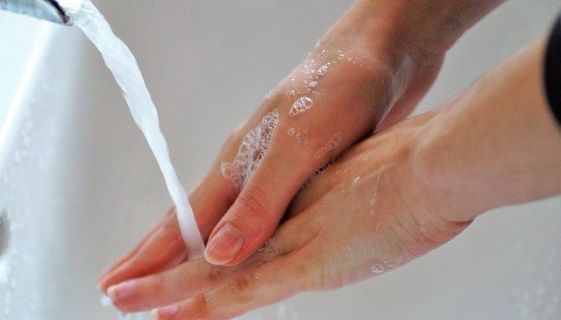Did you know that the clothes you’re wearing right now, your cozy sheets, or even your kids’ pajamas might contain harmful chemicals? Whether you’re concerned about personal health or the environment, learning more about the chemicals used in textiles and how to make safer choices can have a significant impact on your health.
⭐️ FREE GUIDE: Resources for Safe and Non-Toxic Textiles, Clothing + Products
The Hidden Dangers of Everyday Textiles
We encounter textiles everywhere—clothing, towels, bed linens, curtains, upholstery, and more. What many don’t realize is that these seemingly harmless fabrics can be filled with toxic chemicals like PFAS (Per- and Polyfluoroalkyl Substances), formaldehyde, BPA, and heavy metals. These chemicals are often added during the production process for such purposes as waterproofing, wrinkle resistance, flame retardance, and color preservation.
But these chemicals come at a cost to our health. Studies have linked exposure to certain chemicals in textiles to a range of health issues, including:
- Skin irritation and allergic reactions
- Headaches, respiratory issues, and hormone disruption
- Long-term risks such as cancer, reproductive issues, and thyroid dysfunction
For example, PFAS, often called “forever chemicals” because they don’t break down easily, have been associated with various cancers and immune system issues. They’re commonly found in waterproof and stain-resistant fabrics, from school uniforms to hiking gear to yoga pants.
The Health Risks of Textile Chemicals
Many of the chemicals used in textiles can be absorbed through the skin, inhaled, or even ingested—especially when sweating or during physical activity. Our eBook highlights some of the most concerning chemicals found in everyday textiles:
- PFAS: Used in waterproof and stain-resistant fabrics, PFAS are linked to cancer, hormone disruption, and immune system issues.
- Formaldehyde: Often found in wrinkle-free and antifungal treatments, this known carcinogen is present in common clothing items like cotton blends and rayon.
- BPA: A hormone-disrupting chemical found in sports bras, socks, and leggings, BPA has been shown to affect the reproductive and endocrine systems.
These chemicals don’t just affect us as wearers. Textile workers face increased risks of cancer, including lung, breast, and colon cancers, due to long-term exposure to these chemicals.
The Environmental Impact of Toxic Textiles
Beyond the personal health risks, the environmental impact of textile production is staggering. The fashion industry is responsible for:
- 25% of global chemical use
- 20% of the world’s wastewater
- 35% of ocean plastic pollution, largely from laundering synthetic fabrics like polyester
Microplastics shed from synthetic fabrics during wear and laundering contribute to ocean pollution and can even enter the air we breathe. These tiny fibers have been found in human blood, organs, and other tissues, raising serious concerns about their long-term health effects. Studies have even found microplastics in exhaled dolphin breath.
What Can You Do to Reduce Toxic Textile Exposure?
If the idea of toxic chemicals in your clothes makes you uneasy, you’re not alone. But don’t worry—there are actionable steps you can take today to reduce your exposure and shop smarter for safer, non-toxic textiles.
Here are some practical tips:
- Opt for natural fibers like cotton, linen, wool, silk, and hemp—often referred to as “The Natural Five.” These fabrics are less likely to contain harmful chemicals compared to synthetics.
- Avoid synthetic fabrics such as polyester, nylon, acrylic, and spandex, which are petroleum-based and often treated with chemicals.
- Check labels for certifications like GOTS (Global Organic Textile Standard), Bluesign, or Oeko-Tex to ensure the products you’re buying are free from harmful chemicals.
- Wash before wearing: Always wash new clothes before wearing them to remove any residual chemicals from the production process.
- Avoid “anti-odor,” “stain-resistant,” and “wrinkle-free” products. These marketing terms often indicate that the fabrics have been treated with chemicals like PFAS or formaldehyde.
Detoxing Your Closet: Start Small for a Big Impact
You don’t have to overhaul your entire wardrobe overnight. Start by making small changes that can have a significant impact on your health. For example:
- Replace synthetic pajamas and bed linens with organic cotton alternatives. Look for snug-fitting, natural fiber pajamas for your children to avoid flame retardants.
- Choose organic workout gear made from moisture-wicking, breathable fabrics like wool or organic cotton, and avoid synthetic blends that may contain BPA or other chemicals.
- Be mindful of rain gear and outdoor clothing: Many water-resistant items contain PFAS, so seek out PFAS-free options.
By making more informed choices, you can reduce your exposure to harmful chemicals and contribute to a more sustainable and healthier future.
Looking for specific recommendations for safer, non-toxic textiles? Check out our Resources for Safe and Non-Toxic Textiles, Clothing + Products. This guide includes:
- Lists of PFAS-free brands
- The best organic, non-toxic clothing brands for men, women, and children
- Sustainable options for workout gear, furniture, and home textiles
By making informed decisions and transitioning to safer textiles, you can protect yourself, your family, and the planet from the harmful effects of toxic chemicals in clothing.
Discover more anticancer lifestyle tips and explore our full range of free resources, including webinars, eBooks, and the Anticancer Lifestyle Program course. Start your journey today!





